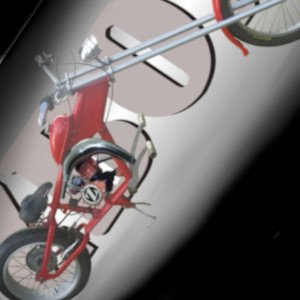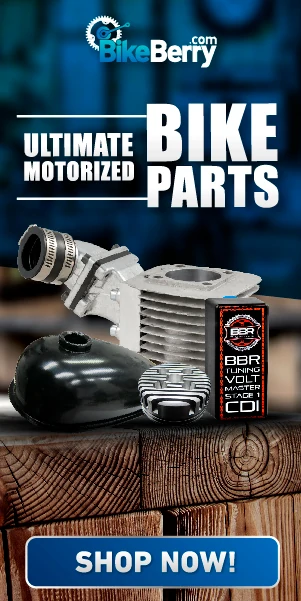The Best 2-Stroke Exhaust for a Motorized Bicycle
The Ultimate guide to Motorized Bike 2-stroke exhausts
More Power For Your Motorized Bike
Every owner of a motorized bicycle wants to know how to increase the power of their motorized bike.
There are several ways to increase the speed of a bicycle motor, however, the most significant performance upgrade for any motorized bicycle is a 2-stroke exhaust expansion chamber. A well-tuned 2-stroke exhaust system can provide a greater boost than any other aftermarket part.
A tuned 2-stroke exhaust not only delivers more umph to the rear wheel, but it also improves fuel efficiency and contributes an incredible sound.
For the savvy motorized bicycle rider, a well tuned expansion chamber is not optional equipment.
What is a Motorized Bicycle Expansion Chamber?
2-stroke exhaust systems work in harmony with the combustion cycle, providing two benefits. Expansion chambers help to pull gasses through the engine during the exhaust stroke. In addition, they force unburned fuel/air back into the combustion chamber on the compression stroke.
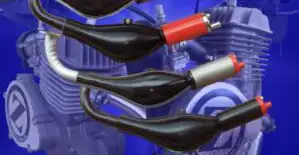
There are three sections to a tuned 2 stroke motorized bicycle exhaust: the header pipe, the expansion chamber, and the tailpipe.
After the header, the tube increases into a wider section pipe, which allows the 2-stroke exhaust gasses to expand. At the end of the wide section, the expansion chamber narrows sharply to a small opening.
The design causes a pressure pulse to be transmitted back to the exhaust port, creating resonance at a specific frequency.
How 2-Stroke Power Pipes Work
A tuned 2-stroke exhaust enhances engine performance by increasing gas flow. Pressure pulses resonate in harmony with the engine at a specific RPM.
At the resonant frequency, the header pipe is low pressure on the exhaust stroke, and high thrust on the compression stroke.
During the exhaust stroke, low pressure in the header draws out burnt gasses from the combustion chamber creating a vacuum effect that facilitates the intake of more fuel:air from the carburettor.
During the compression stroke, a pressure wave in the header forces gas back into the combustion chamber. Increased pressure of around 7 psi (ref: Two-stroke Tuner’s Handbook by HP Brooks) pushes gas back into the cylinder just before the exhaust port closes.
In addition, the high and low thrust cycle in the header allows the duration of inlet and exhaust ports to be increased. Port modifications can further improve efficiency.
4-Stroke Expansion Chambers
4 stroke expansion chambers do not enhance agility. Unlike 2 stroke bicycle motors, a 4 stroke internal combustion engine includes an exhaust valve. 4 strokes have a dedicated engine cycle for expelling exhaust gas. Any backpressure in the header is counterproductive.
Although negative pressure is beneficial, 4 stroke engines can benefit from low pressure by simply adjusting the length of the silencer.
In highly sophisticated 4-stroke racing mufflers, CPU’s can operate a servo to vary the length according to the RPM, inducing a negative pressure wave.
Why Do 2-Strokes Need An Expansion Chamber?
Expansion chambers boost acceleration and increase brawn. The motor “breathes” more easily, which increases its efficiency. Increased efficiency results in burning less fuel to improve performance.
While there are numerous reasons to install a customized exhaust on your bike, the most notable is the significant boost in grunt that your vehicle can achieve at high RPMs.
If you enjoy pushing your motor vehicle to the limit, a custom exhaust gives an additional boost at higher revs.

2-stroke exhaust on a motorized bicycle
An aftermarket exhaust is the first performance part that a motorized bicycle rider should install.
wave.
Incorrect Design
The problem with many customized 2-stroke exhausts for motorized bicycles (and tricycles) is that they often do not operate in harmony with the engine. A poor design will slow down any motorized vehicle and can increase running temperature.
The resonance effect of the expansion chamber can only increase function in a specific rev range. Poor design can be detrimental to gasoline 2-stroke engines.
Poorly designed systems can result in the motor sucking gas from the chamber on the compression stroke and create resistance against gasses attempting to exit during the exhaust stroke.
It is important to purchase or build a performance exhaust pipe that is designed correctly for your engine’s specifications.
A Racing Pipe on a Bicycle Motor
For the system to deliver maximum effect, the rev range must be narrow.
The broader the rev range of the designed power-band, the less effective the expansion chamber becomes.
For a narrow power-band that provides maximum potential at 4,000 RPM, effectiveness drops off quickly as the RPMs increase above or drop below this range.
This means that riders must keep the motor running full throttle to achieve maximum benefit. The motorized bicycle produces less torque at lower revs which reduces the bike’s ability to pull from slow speeds.
A bicycle with a racing exhaust system can be extremely difficult to ride.
Motorized Bike Exhaust Modification
Both 50cc and 80cc bicycle engine kits incorporate high-performance design into stock mufflers. It surprised me to discover that many dimensions of standard silencers utilize proven performance parameters.
Standard silencers, however, have several internal baffle chambers. These reduce noise at the expense of efficiency.
The following simple 2-stroke exhaust modification can deliver 75% of the boost that a high quality expansion chamber provides.
Before going to the trouble of welding your own custom system, it may be worth experimenting by cutting 1 inch off the inside of the stinger pipe. Replacing the stinger with a slightly shortened version typically results in a significant increase in torque and RPM.
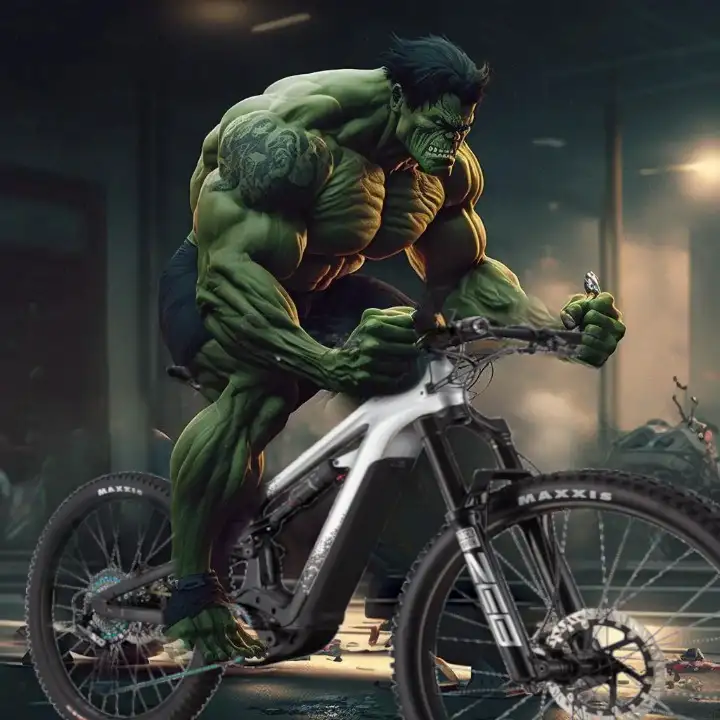
2-stroke exhaust expansion chamber
A tuned 2-stroke exhaust can increase power more than any other performance part.
On most bike motors, a single bolt secures the stinger to the end of the muffler.
As a word of caution, make sure to check if 49cc engine mods breach motorized bicycle laws. All US states allow electric bikes; however, only a few permit motorized bikes or scooters. Additionally, there are limitations on the horsepower and pace of bicycle motors.
Motorized bikes do not automatically classify as regular bicycles just because they have pedals. Check whether motorized bicycles are classified as motor vehicles, mopeds, or motorcycles that require a valid driver’s license.
Building Expansion Chambers For Motorized Bicycles
Building a custom 2-stroke exhaust requires different cross sections of metal tube cut to size and welded together. The skill is in knowing the correct tube lengths and diameters required.
Starting Point
There are 2 fundamental aspects of a 2 stroke motorized bicycle that dictate the power pipe design
1. The diameter of the exhaust port of the barrel.
- The RPM that you want to obtain maximum boost.
Expansion chambers use three different diameter sections of tube. Knowing the diameter of the first section is easy.
Header Pipe
The header diameter should match the dimensions of the exhaust port of the engine barrel.
If your exhaust port is 18mm diameter, you need a 18mm diameter header.
If you do not have access to tubing with the perfect inside diameter, then use a slightly larger header. You can then use a dremel to grind out the exhaust port to match the header cross section.
The exhaust ports on my preferred 80cc bike engines have a rectangular profile, 12mm high and 22mm wide. Using a vise to squash a 20mm pipe, I then use a dremel to create a smooth flow from the inner wall of the barrel to the outer casting.
This header is substantially wider than the restrictive 12mm diameter of a stock muffler.
The length of the header should be between 6 and 11 times the diameter of the exhaust port, with 8 being ideal. Length may be determined by where you want to position the pipe on the bike. For convenience, it is useful to keep the expansion chamber exhaust short and out of the way.
For an 18mm diameter port, the ideal header should be 144mm.
Header Taper
In an ideal situation, the header cone should taper out slowly from the header at 8 degrees. This allows for the longest power-band. A steeper taper results in a slightly stronger effect but a much shorter duration.
Exit Aperture
Moving on to the next relatively easy parameter to calculate, the width of the exit aperture. This is directly proportional to the diameter of the header. The exit aperture should be between 0.57 to 0.62 the size of the inlet pipe.
I have tested more restrictive exit apertures with beneficial effect. The smaller the exit, the more the performance improved. I believe that the additional compression helps force extra unburned gas into the header.
I leave it to you to test this phenomenon, as experts have painstakingly calculated the above dimensions.
A cone end section should transition quickly from the midsection to the exit tube.
Mid Section Width
For maximum effect, the diameter of the mid section should be 6.25 times wider than the inlet pipe.
Mid Section Tuned Length
We can calculate the length and angles of the chamber using the formula.
L = (E x V) / N
Where
L = Length of header and mid section in inches
E = Exhaust open period in degrees
V = wave velocity in feet per second
N = Crankshaft rotation in RPM
Parameters for a 2-stroke bike engine would typically be:
Exhaust open period = 180 degrees
Typical wave velocity = 1700 feet per sec.
RPM = 4,000
Plugging these figures into our calculation, we have:
L = 180 x 1700 / 4000 = 76.5 inches (or 183.6 cm)
I have worked with many manufacturers. None calculate the midsection length.
Performance parts builders use the widest practical pipe diameter and length that will fit onto the bike (or cart). They then test performance on a Dyno. If adjustments are required, they add small sections of header or tail pipe lengths.
Jake Perkio provides a helpful 2-stroke exhaust calculator using formulae from Jennings Two Stroke Handbook.
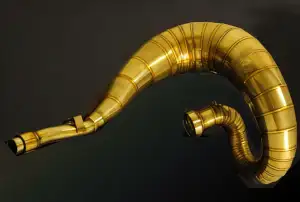
2-stroke exhaust expansion chamber
A tuned 2-stroke exhaust can be compromised to allow fitting
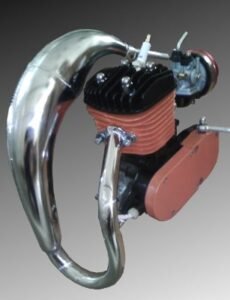
2-stroke exhaust expansion chamber
A tuned 2-stroke exhaust can be compromised to allow fitting
Conclusion
An expansion chamber exhaust is the most potent upgrade for a motorized bikee. They improve acceleration, speed, sound, and engine efficiency.
2-stroke exhausts pull gasses through the engine during the exhaust stroke. They force the unburned fuel/air into the combustion chamber during the compression stroke.
The article also provides simple instructions for modifying a standard 2-stroke exhaust by cutting off a portion of the stinger. It also includes specifications for constructing a perfect power pipe for a bicycle motor.
